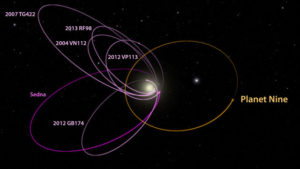I recently read Beyond Cloud Nine by Greg Spry and saw an announcement of a suspected Planet Nine. I thought of the two together because so much of the book takes place out in our solar system
I really liked the book. It was an exciting story set in the not too distant future.
There are well described and choreographed space battles. The mysterious foes out maneuver all the good guys, but the heroine’s faster reflexes allow her to survive.
I really liked the author’s treatment of the science. He consistently kept within the bounds of plausibility and explained things in an easily understood way. In the book a scientist has come up with a way to get around the solar system more efficiently and possibly travel to the stars.
Without going into spoiler details, I like what he came up with. It is akin to what I use in my Janus Unfolding series, only he uses machines and I use minds.
The other aspect of the story that is interesting is the mysterious opposition: what they do and why they are doing it. It’s a new twist on an old theme that I found fun to uncover as I read the book.
Shortly after I read Beyond Cloud Nine there was an announcement about a mysterious Planet Nine that is postulated to be beyond Neptune.
No one has detected it, but the scientists say that a planet with ten times the mass of earth, 155 billion miles away would be the best way to explain certain eccentric orbits of other objects in the Kuiper belt and explain why the sun’s axis is tilted relative to the plane of the other planet orbits.
There were a number of articles, but I thought this one by John Timmer, the science editor at Ars Technica described it well. I’ve provided the first couple of paragraphs and a link to his article if you want to look into I further.
The possible ninth planet could explain a tilt in the Sun. Calculations suggest a Solar System oddity could be due Planet 9.
JOHN TIMMER – 10/21/2016,
Caltech/R. Hurt (IPAC)
Ideas about a possible ninth planet have been kicking around since shortly after we discovered the eighth in 1846. But so far, all that we’ve come up with is Pluto and a handful of other objects orbiting out in the Kuiper Belt. And these dwarf planets simply don’t have the mass to have a significant gravitational influence on our Solar System.
But our inability to find anything big beyond the known planets may just have been because we weren’t thinking radically enough. One of the people responsible for the discovery of a number of Kuiper Belt Objects noticed an odd alignment in their orbits. When running models of how that oddity could be produced, he and his team found that a large planet with an extreme orbit would work.
Calling it Planet 9, they suggested it could be over 10 times Earth’s mass and so far out it takes 20,000 years to complete one orbit. Planet 9, they speculated, has a lopsided orbit that’s tilted relative to the other planets and much closer to the Sun on one side.



